- Nanoelectronics and the effect of quantum confinement
What is the relationship between nanoelectronics and the quantum confinement effect? (Uses in nanoelectronics)
Researcher and Author: Dr. ( Afshin Rashid)

Note: Quantum nano-effects are important in most materials and create different properties than what we are familiar with on the macroscopic scale. Nanophysics forms the basis of many phenomena in medicine, life sciences, and chemistry and is an important interface to these sciences.
The electronic and optical properties and surfaces of various materials are interesting and novel. Nanoquantum is based on the continuous development and refinement of nanoscale imaging techniques, the resolution of which reaches the atomic scale. Nanoelectronics enters new materials and various areas of power technology, (nanoscale sensing devices, tools for medical diagnostics, energy efficiency and storage, and solar technology). Quantum physics phenomena can be observed with electrons, atoms, or photons and in dense matter systems such as metals or semiconductors, which play an important role in our daily lives.

In the world of nano-quantum, we observe many amazing and at first glance unusual phenomena - such as quantum particles that can simultaneously collide in different places, or quantum jumps whose exact point in time is essentially random. As confusing as these phenomena may seem, we are already seeing signs that will form the basis of the modern technological revolution. There is almost no other field of science where basic research and pure technological applications and its revolutionary impact are so seamlessly intertwined as in nanoelectronics.
_evfp.gif)
Nanoquantum is a hot topic, a rapidly growing field of quantum computing and quantum technology. It combines quantum physics with nanotechnology to develop, among other things, ultrafast supercomputers and new measurement tools that will revolutionize many areas of science, communications, and the Internet. Nanoelectronics brings together many important areas of quantum physics, such as solid-state physics of metals, superconductors, semiconductors, ferromagnets, graphene, quantum Hall and topological systems, low-temperature physics, scanning probe physics, and nano and quantum optics. Current nanoelectronic technologies in nanomemory hardly meet the demands, but nanotechnology offers better solutions. One new data storage tool is the use of nickel quantum dots in nanometer sizes, which are expected to be used to store terabytes of data, even in homes and personal use.
Conclusion:
Nano quantum effects are important in most materials and create different properties than what we are familiar with at the macroscopic scale. Nanophysics forms the basis of many phenomena in medicine, life sciences, and chemistry and is an important interface to these sciences.
Researcher and Author: Dr. ( Afshin Rashid)
Specialized PhD in Nano-Microelectronics


